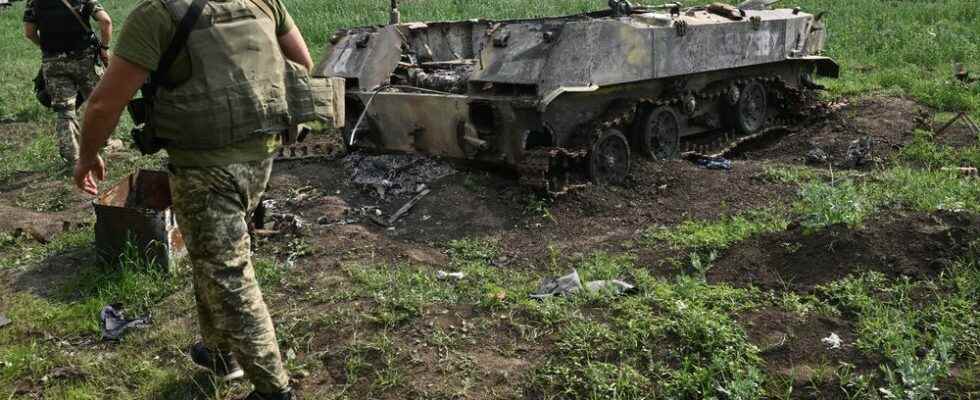Night and day, a deluge of fire falls on Sloviansk. “My main advice: evacuate!” Regional Governor Pavlo Kyrylenko launched on Tuesday, July 5, denouncing “pure and simple terrorism” from Russia. Earlier in the day, Russian strikes against a market left two dead and seven injured. This city in the Donetsk region – of around 100,000 inhabitants before the start of the conflict – is the next target for Russian forces, after the capture, on Sunday July 3, of Lyssytchansk, 70 kilometers further east.
The fall of this Ukrainian bastion has formalized Moscow’s control of the Lugansk region, which forms, with that of Donetsk, the Donbass, on which Putin wants to take control. “It was the first stage of the Russian plan, notes General Dominique Trinquand, military expert and former head of the French mission to the UN. If Russia manages to seize the Donetsk region, its objective of conquering the Donbass will be achieved.” After the failure of its generalized offensive on Ukraine launched on February 24, the Russian general staff announced at the end of March that it would concentrate its efforts on “liberating” this mining basin.
Sloviansk and Kramatorsk, two major obstacles
However, two major obstacles still stand in the way of the Russian forces. Besides Sloviansk, the city of Kramatorsk – of a comparable size and located 15 kilometers further south – is the other major Ukrainian stronghold in the area. In 2014, the two cities had fallen into the hands of pro-Russian separatists before being taken over by Ukrainian forces after three months of siege. “This conurbation will be the hard point of the new phase of confrontation which is beginning, underlines Olivier Kempf, director of the strategic cabinet La Vigie, and associate researcher at the FRS. In recent years, the Ukrainian forces have largely fortified their positions around these two cities.
In any case, the master of the Kremlin makes no secret of his intentions. The day after the capture of Lysytchansk, Putin ordered the Russian forces to continue their offensive in the East “according to the plans already approved”. For the time being, Moscow controls a little more than half of the Donetsk region, where the bulk of Ukrainian forces are now concentrated. But on the ground, progress remains very sluggish. “We have the impression of a phenomenal progression of Russia in Ukraine, but in the month of June, its territorial gains actually represent an area of the order of that of Luxembourg”, notes François Heisbourg, adviser to the International Institute for Strategic Studies (IISS).
A Ukrainian soldier walks past a destroyed Russian tank in a field south of the town of Mykolaiv on June 12, 2022
afp.com/Genya SAVILOV
Sign of a latent shortness of breath, the Russian president declared Monday July 4 that the units having taken part in the offensive of Lugansk had to “rest” the time to “rebuild their combat capacities”. In its daily briefing, Britain’s Ministry of Defense said the following day that the Battle of Donbass had so far been marked by “slow progress and heavy use of artillery by Russia”. And to add: “the fighting in Donetsk Oblast will most certainly continue in this way.”
Arrival of the western artillery
After four months of grueling conflict, do Russian forces still have the capacity to increase their gains? “I do not believe in a collapse of the Russian army, but a form of material and human exhaustion could end up happening, estimates Mathieu Boulègue, researcher specializing in Eurasia at Chatham House, a London think tank. he offensive on Sloviansk and Kramatorsk will probably be very difficult for the Russian troops, as the Ukrainian positions have several defensive lines.” Although costly in manpower, the resistance of Severodonetsk and Lysychansk bought the Ukrainian forces valuable time.
If, at the beginning of July, Ukraine had received only four American Himars multiple rocket launchers – with a range of 70 kilometers – the United States has committed to deliver eight by mid-July. At the same time, 450 Ukrainian soldiers began a three-week training course in the United Kingdom at the end of June, in order to familiarize themselves with the handling of this weapon. Because London intends to deliver three more, just like Germany. “The arrival of modern Western artillery will allow Ukraine to set up powerful defensive bastions, judge General Trinquand. We can expect that Ukraine will concentrate all its efforts in the defense of these two cities.”
Because the loss of these two agglomerations would considerably complicate the defense of the rest of the region. On the other side of the border, the Russian appetite does not seem to weaken. On Tuesday July 5, Russian Security Council Secretary Nikolai Patrushev said that Russia will continue its “special military operation” until it achieves its initial goals of “denazification”, “demilitarization” and ” neutralization” of Ukraine. Without specifying whether Russia would then stop at the borders of Donbass.
